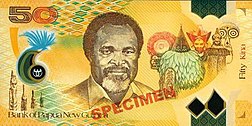Papua New Guinea Kina
| Papua New Guinean kina | |
|---|---|

Commemorative K50 Note
|
|
| ISO 4217 | |
| Code | PGK |
| Denominations | |
| Subunit | |
| 1/100 | toea |
| Plural | kina |
| toea | toea |
| Symbol | K |
| Banknotes | 2, 5, 10, 20, 50, 100 kina |
| Coins | 5, 10, 20, 50 toea, 1 kina |
| Demographics | |
| User(s) |
|
| Issuance | |
| Central bank | Bank of Papua New Guinea |
| Website | www |
| Valuation | |
| Inflation | 1.8% |
| Source | The World Factbook, 2007 est. |
The kina (ISO 4217 code: PGK) is the currency of Papua New Guinea. It is divided into 100 toea. The kina was introduced on 19 April 1975, replacing the Australian dollar at par. The name kina is derived from Kuanua language of the Tolai region, referring to a callable pearl shell used widely for trading in both the Coastal and Highlands areas of the country.
For earlier currencies used in Papua New Guinea, see New Guinean pound and New Guinean mark.
In 1975, coins were introduced for 1, 2, 5, 10 and 20 toea and 1 kina. The 1 and 2 toea were minted in bronze, with the others in cupronickel. The 1 kina is round and holed in the centre, this denomination was reduced in size starting from 2006, and the larger coin was demonetised from the 31 December 2008. 2008 also saw the introduction of a bimetallic 2 kina coin intended to replace the 2 kina note. The withdrawal of the 1 and 2 toea coins also occurred in 2006 and as from the 19 April 2007 are also no longer legal tender. In 1980, 50 toea coins were introduced but only issued in commemorative form without a standard design.
On 19 April 1975, notes were introduced for 2, 5 and 10 kina that replaced the Australian dollar at par, so the colour scheme was the same. They circulated along with the dollar until the 1 January 1976 when the dollar ceased to be legal tender. The 20 kina was introduced in 1977, 50 kina in 1988, followed by 100 kina in 2005. All colouration of the individual denominations are the same as current and former Australian decimal currency. Beginning in 1991, Papua New Guinea's banknotes have been produced on polymer, although in 2009 the bank issued Kina & Toea Day commemorative notes on paper substrates.
A new issue of banknotes has been issued starting with the 50 kina in 1999, then the 100 kina in 2005, 2 and 20 kina in 2007 and the 5 and 10 kina in 2008. This makes all the denominations of the kina issued in polymer. Paper bank note ceased being accepted by the Bank of PNG from the 31 December 2014, and are no longer legal tender
...
Wikipedia
